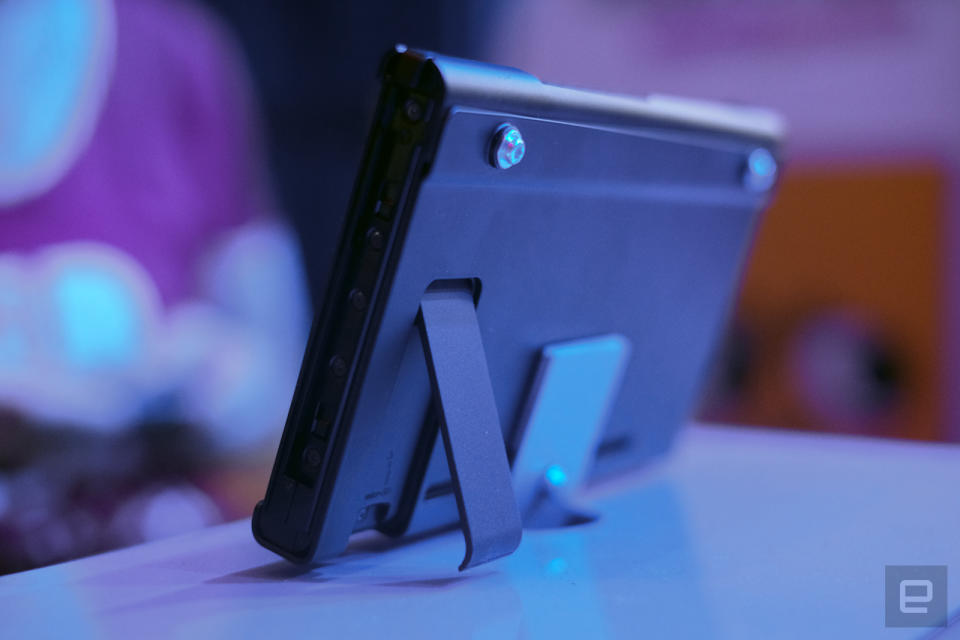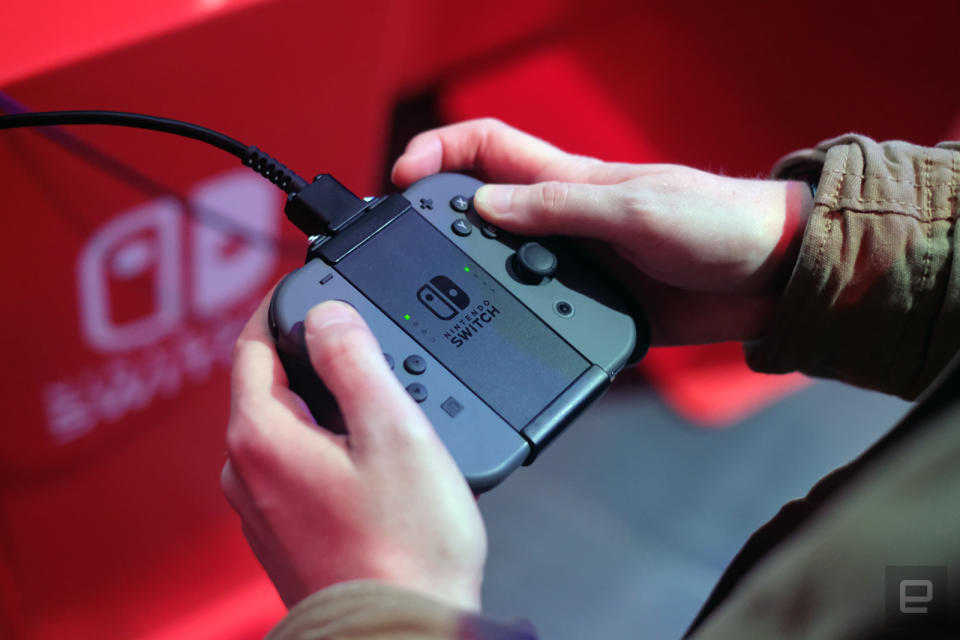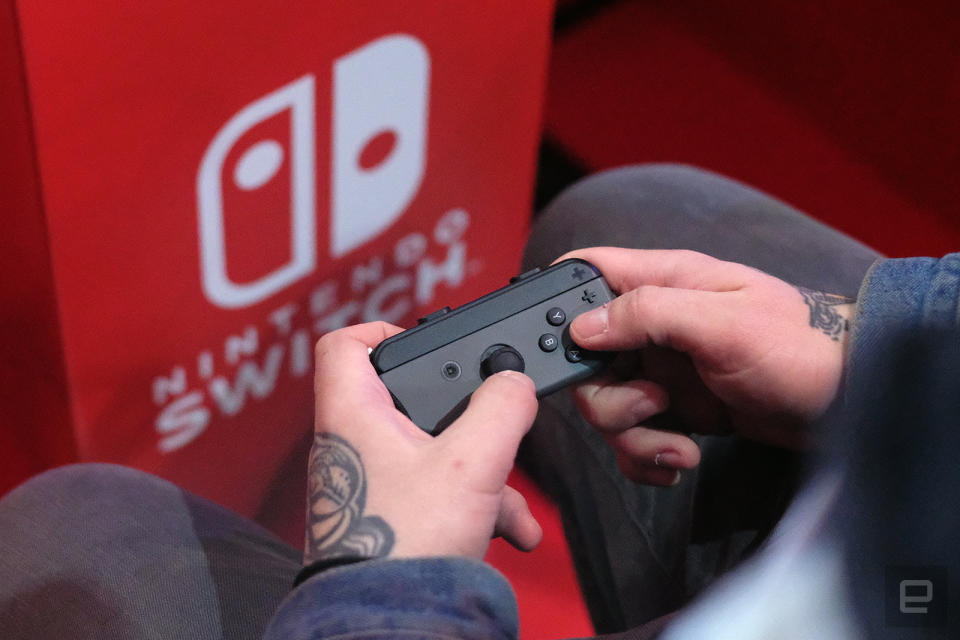Nintendo's Switch makes a great first impression
It's surprisingly comfortable.

Well, this is different. In my hands is Nintendo's Switch, a $300 (£280 in the UK) console that's like nothing I've held before. Well, it's like quite a few things, but nonetheless a unique device.
It all starts with a tablet, dominated by 6.2-inch 720p capacitive touchscreen, with speakers in the lower corners. It's thick, by anyone's standards, but it's not too heavy, and is generally well-balanced and comfortable to hold. The screen, although low-res compared to most tablets, looks sharp, bright and rich. Viewing angles also seemed good -- vital for two-player sessions.
At the top of the tablet portion is a slot for proprietary game cards, a headphone jack, two volume keys and a recessed power button. Below is a microSD card slot and a USB Type-C charging port. Around the back is a sturdy kickstand that lets you rest the tablet on a table. Adorning the vertical edges of the tablet are detachable "Joy-Cons" that connect via rails.

With the Joy-Cons attached, the Switch turns into a giant gamepad, with similar dimensions to the Wii U. Unlike the Wii U, the analog sticks are laid out asymmetrically, giving the controller a feel closer to the Xbox pad (or indeed, Nintendo's GameCube controller) than the PlayStation 4's DualShock. As someone who never really liked the two analogs at the top of the Wii U (or, indeed, at the bottom of the Wii U's Pro controller), I'm very happy with the layout.
The (clickable) analog sticks also feel way better than the Wii U's. They're smaller, which might be a problem for some people, but they're also lower and more rigid than any sticks Nintendo has built before. I can't be sure that they won't loosen over time, but right now I'm loving the way they push back against your thumbs.
All the other buttons are as clicky and responsive as you'd expect from a company that has pretty much defined how we control video games. The right-sided Joy-Con has Nintendo's traditional A, B, X, Y face buttons above the analog stick, and a circular home key below. In the upper-left corner of the pad, there's the familiar "+" button, a holdover from the Wii U. The buttons are smaller than those on a traditional console, but not uncomfortably so.
The left Joy-Con has the analog up top, circular directional buttons (no traditional d-pad here, for reasons we'll get to in a minute) below and a "capture" key at the bottom. That capture button behaves like the Share key on a DualShock, instantly taking a screenshot for you to post. Nintendo says that, much like Sony's setup, it'll eventually capture video as well. Nintendo hasn't exactly greeted YouTube and Twitch users with open arms, -- on many occasions, it's prevented YouTubers from making money from gameplay videos -- so it'll be interesting to see if it's finally opening up on that front.

As you well know, the Switch is not just a portable console. Pop it down on a table (using the aforementioned kickstand) or in its TV dock and the controller experience is very different.
Each Joy-Con slides out of the tablet smoothly (it's very satisfying, and makes me worry I'm going to randomly be doing that all the time because I am weird like that). Once they're out, you can either slide them into a plastic shell called the Joy-Con Grip, or use them individually. Let's cover the Grip first.
The Grip is very compact, and its squared front will take some getting used to for sure, but in general it feels exactly the same as the Switch does in hand-held mode. The grips are slanted and ... grippy, for lack of a better word, and offer enough space for my fairly brutish knuckles to nestle behind without brushing up against each other.

Used individually, the controllers aren't quite as ergonomic. Nintendo encourages you to slide them into a "Joy-Con Strap" (because everything must have a proper noun), which makes them a little taller, but doesn't improve things too much. Each offers an analog on the left, two buttons up top and four face buttons on the right (that's why there's no d-pad). You can use these controllers without with Strap, but the shoulder buttons aren't as pronounced, and, well, Nintendo is packing two Straps in with the console, so why would you?
Using a solo Joy-Con as a traditional controller is kind of like holding an overly complex Game Boy Micro. It definitely won't be comfortable for adults to use over long periods of time, but in a pinch, it'll let you host a quick local multiplayer session.

Each Joy-Con does, however, have motion controls, so you can use them much like Wii Remotes. In this orientation, they're just fine, and Nintendo's unique approach here means you can play two-player games straight out of the box. They also have an advanced force feedback system that offers a degree of sensitivity that you don't typically get from game controllers.
All told, the Switch, as revolutionary as it sounds, really just feels like Nintendo nailing what it tried and failed to accomplish with the Wii U. It's a game console you can play in the living room, bedroom or pretty much anywhere. People can point to a lack of cutting-edge graphics, but in 2017, it's difficult to see how Nintendo could've balanced battery life, power and ergonomics any better. Moreover, if it treats this console like it has its portables over the years, we'll likely get faster, slimmer and longer-lasting iterations of the Switch sooner rather than later.
We've got a separate post with brief impressions of all the games on show at Nintendo's launch event, but for now, all you need to know is the Switch makes a very good first impression. It'll launch March 3rd.
Click here to catch up on the latest news from Nintendo's Switch event.
